I think we can all agree that trees are a positive sign of life and remind us of the beauty of nature. What about dead trees, though?
On the one hand, they cannot grow and produce life recharging foliage. On the other hand, though, they can still provide shade, shelter and a home for certain animal and/or bird life and add a different kind of beauty to the landscape.
There are instances that a standing dead tree may pose some issues, though, especially in a home space or backyard. Do you know how long can a dead tree remain standing?
Honestly speaking, there can’t be a definitive answer to this question, as every tree is different in many ways. However, if we average out the most general cases, then it comes out to be 1-2 years.
It could be standing extremely close to a house and on the verge of collapse. It may even have its roots under a foundation which can also cause major headaches. Knowing how long a dead tree can remain standing is an important piece of knowledge.
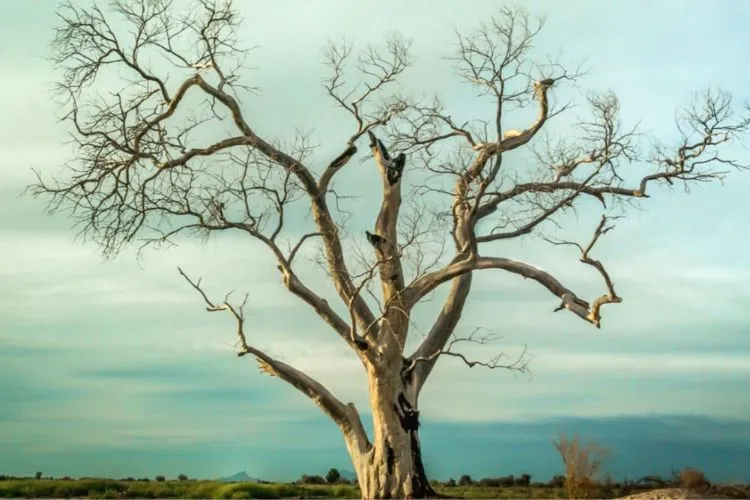
It helps to ensure an area can be safe from any harm it may cause if it collapses. In this article, we’ll look at how you can tell if a tree is completely unsavable, as well as actions that can be taken to correct the issue.
Table of Contents
How do you tell if a tree is completely dead?
Those lush, vibrant colors of a living tree offer us a visual sign that it is alive and growing happily. When a tree is dead, it will often look both lifeless and dull. A simple scratch test is an easy way to tell if a tree is completely dead.
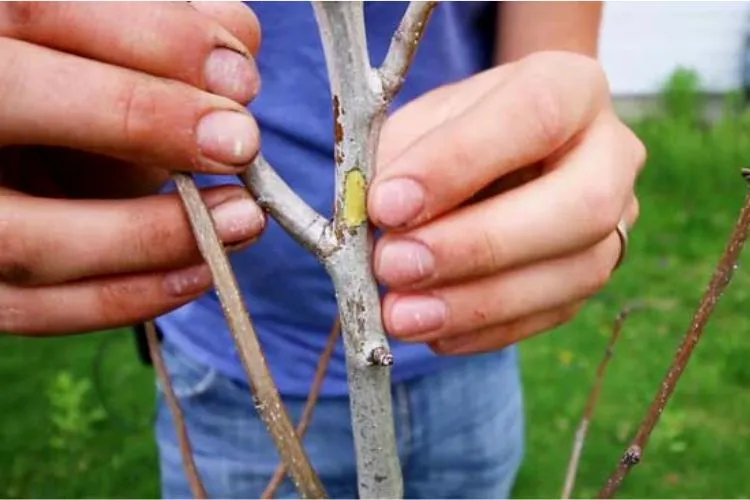
This can be done by carefully removing a patch of the dry outer layer of the tree’s bark. Beneath this outer layer is another layer known as the ‘cambium’ layer. If the tree still has some life, this cambium layer will be green in color and often still quite moist.
In contrast, a dead tree will be both dry and brown upon an investigation of the same layer. Additionally, a dead tree will either have very few leaves or none. This will depend on how long it has been lifeless. You may also spot signs of fungus growing around the trunk base.
How long can a dead tree remain standing?
There is no universal timeframe for how long a tree will remain standing after dying. This is because all trees are different in size, species, age, shape, and structure, growing under conditions that could prop them up for longer than others. In general, though, most trees can remain standing if undisturbed for as long as a year or 2.
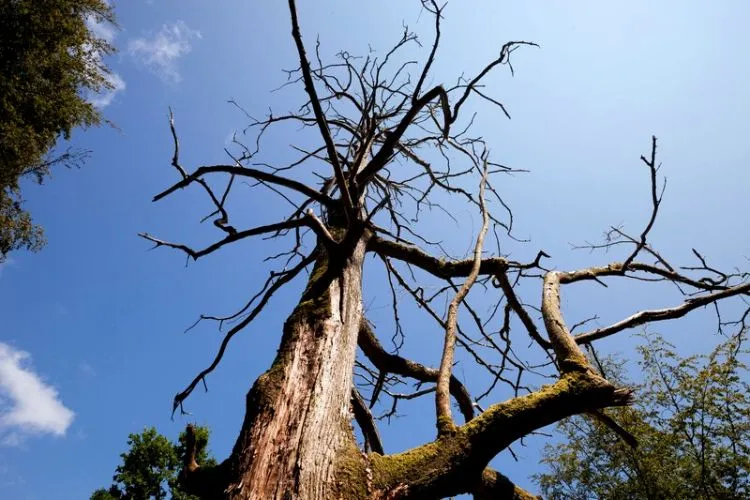
However, external factors may see a tree stand or fall longer than others. These disturbances include:
- Soil Type and Condition – The dead or decaying tree could be growing in extremely soggy and loose soil. As elements such as wind sway them back and forth, they could easily dislodge from their growth patch and fall.
- Moisture Content – If the dead tree has been standing for quite some time and is subject to heavy rains or other means of water intake, it can cause the limbs to become heavier. This extra weight could act as a ticking time bomb waiting to explode. All it takes for a wet, soggy limb is a strong wind to blow it down. Excess humidity can also add to the moisture content.
- Climate – Extreme heat can dry dead trees out. Once a dead tree completely dries out, the limbs can almost be snapped like a small twig.
- Pests/Animals – There could have been various pests and/or animals that used the dead tree as a home or shelter. Over time the weight and constant use could weaken the tree, causing it to fall. Even animals such as bears, moose, wild horses, etc., can ram dead trees and dislodge them from their roots.
- Direct Root Damage – The tree’s roots keep them stable and upright. These areas could have been manipulated during their lifespan by animals or even humans. They could have been hacked away, which leaves them brittle and more easily maneuvered. Softwood is more susceptible to movement and breaking. The extra weight of a tree can do the remainder of the damage.
How do you tell if a tree is going to fall?
A dead tree hangs lifeless around a home or high traffic, and the communal area can be extremely dangerous. It can cause serious injury or damage to anyone or anything it may fall on. The biggest problem is that a tree in this state can fall anytime. It’s a ticking time bomb.
Thankfully there are a handful of signs you can look for to know when a tree in this state is about to give way. With this information, it’s best to avoid the area and even create a barrier to prevent injury or damage. The warning signs include:
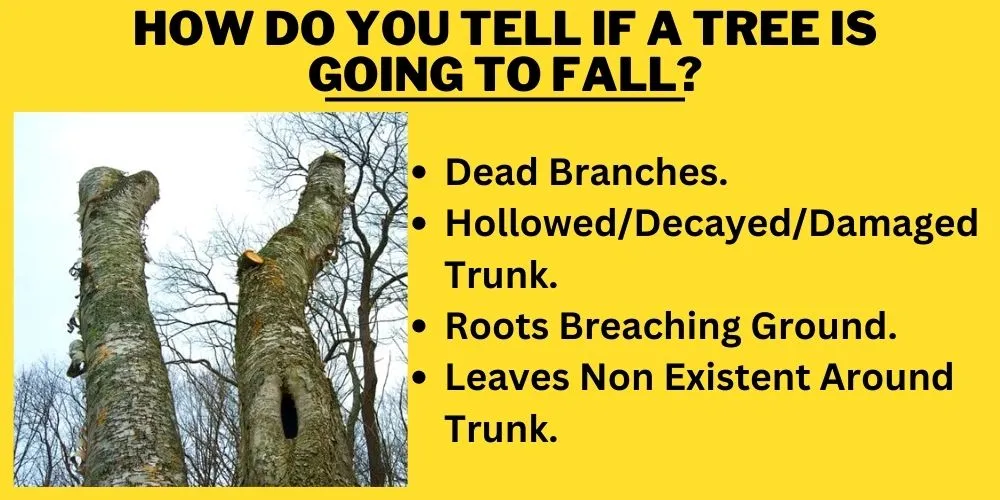
Dead Branches
Dead branches can be a sign of root rot. This means the tree is already dead from the roots and the branches cannot receive any nutrients. Strong winds can easily dislodge branches.
Hollowed/Decayed/Damaged Trunk
Hollowed out areas are similar to cavities in teeth; the only difference is we don’t have dentists that can fill these holes in trees. As the holes become larger, the tree weakens and can easily tumble.
Roots Breaching Ground
If you notice a tree’s roots starting to rise from underneath the ground, the roots may have already rotted and become weak. As the roots become weak, they break more easily and can lift.
When the roots lift on one side, they can then begin to see saw during extreme winds and deteriorating soil conditions. The stability of a tree is in its roots. Once they give way, the whole tree will suffer.
Leaves Non Existent Around Trunk
If a tree is healthy, its leaves will shed from the outside and work their way in. An unhealthy tree can lose its leaves from the base upwards due to a lack of nutrients. The roots take them in and feed the tree from the bottom up.
So if you notice leaves missing or not growing at the base, that’s a sure sign that something is wrong with the trees’ growing conditions. Ctio must be taken before it’s too late.
Is it good to leave dead trees standing?
This thought process should be more based on personal preference as it will all depend on a few factors. If the tree is located in an area considered dangerous or creates some kind of hindrance, it should be carefully removed. It should be planned and carried out so that it doesn’t disrupt the surrounding nature.
Ethically though, a dead tree should stand until the point that it falls on its own accord. Depending on the location, it could provide shelter or shade for animals. Removing it ‘just because’ can jeopardise the well-being of whatever life is living there.
Dead trees can also be seen as bringing life to other organisms. Dead wood can be decomposed by fungi, bacteria, etc., which then assist new plant growth by returning necessary nutrients to that specific ecosystem. It all depends on how you look at a dead tree through different eyes.
Do dead trees eventually fall over?
It’s hard to tell if a dead tree will fall over soon or after quite some time. As we went through above, many factors can cause a dead tree to topple. If the tree was left to fall naturally, you could see it as a helping hand. The tree may have been in the way, but cutting it down yourself could have been a task that you may not be experienced with or ready for.
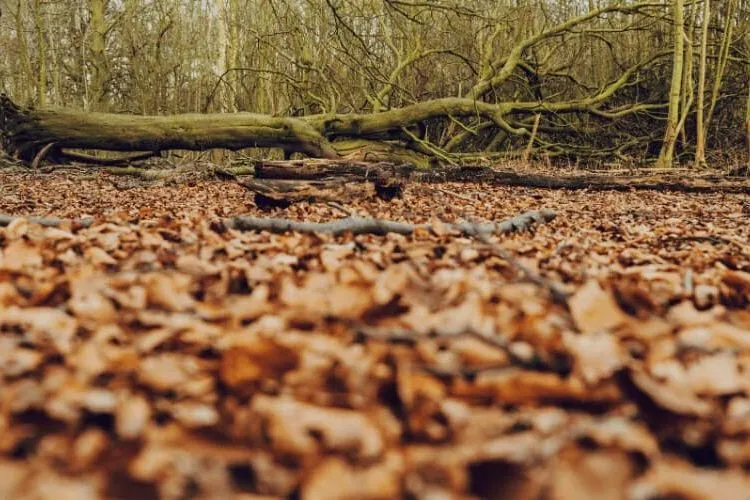
You may not have the equipment or even time to remove it yourself. Sometimes having that little bit of extra patience can help solve problems that may have been previously difficult to deal with. The hardest part about the wait is planning and anxiety.
Simply waiting for a tree to fall alone won’t allow you to put any concrete plans in place if you’re designing an area or something along those lines. Furthermore, waiting for a tree to fall in a place that is considered dangerous can cause the stomach to churn at the thought of each minute trickling by. They will eventually fall over but is the wait worth it?
Is a dead tree a hazard? Why should dead trees be removed?
Dead trees are considered hazardous based on the area in which they are standing. For example, if the tree or its limbs are dangling over a house, barn or some other place that could injure someone or damage something, it is cause for concern.
It may even be blocking a waterway or road or hanging by a thread over some power lines, which are also extremely disastrous for logistics and infrastructure. Also, dead trees in an unwanted area can attract pests, including termites, carpenter ants and other boring wood insects. As these little colonies are formed, they will also become another headache to try to deal with.
On the other hand, if a tree is decaying or dead out in the middle of nowhere and is home to birds, animals or other life bringing ecosystems, it should not be removed. A general rule of thumb for removing dead trees is:
“If it’s wild, the danger is mild,
if it requires a ranger, it’s usually a danger.”
Frequently Asked Questions (FAQs)
How long can a dead pine tree remain standing?
Pine trees have been known to stand upright after dying anywhere from decades to hundreds of years. Their trunks are extremely dense and strong. The only thing that can take them down is if the root system is distrubed or by manual manipulation.
How long will a palm tree stand after it dies?
Palm trees don’t have such a dense structure, and they generally grow a little to one side. This makes them more susceptible to falling over anywhere from a couple of months to 1 year after death. It all depends on many factors, including root establishment, species, age at death, surrounding props, etc.
Conclusion:
The amount of time a tree can remain standing after death cannot be determined without understanding several different variables. These factors have been discussed extensively within this article. Therefore, there is no universal timeframe that we can go by. We hope that this article has been helpful, and we look forward to seeing you in the next one. As always, happy growing!


